

Introduction & Guidance To Business Analysis Planning and Monitoring

More often than not, the outcome of the business analysis project is directly dependent on proper planning.
The business analysis planning and monitoring activity lays out the groundwork necessary for the successful completion of the whole project.

Monitoring also plays a key role in evaluating the business analysis work during the project. Detailed planning and close monitoring are essential for delivering the desired outcomes.
Table of Contents
Introduction – business planning and monitoring.
They determine how changes are requested and analysed and determine the right approach that will satisfy the need of the organisation.
Also, they evaluate how business analysis performance has contributed to the implementation of the solution . As for the stakeholders , the BA’s job is to analyse their needs and characteristics to ensure proper planning and monitoring.
Furthermore, at this stage, they need to conduct performance analysis so the planned activities will deliver a satisfying value to the business.
All of this would not be possible without ensuring a complete understanding of the organisational context and developing the right analysis approach.
The BABOK guide includes five tasks that BAs should perform as a part of the business analysis planning and monitoring knowledge area.
These tasks focus on organising and coordinating analysts and stakeholders, planning the approach to specific parts of a project, and defining the roles. They should produce outputs that can serve as a foundation for tasks in other knowledge areas. We’ll take a closer look at all five of these tasks.
Plan Business Analysis Approach
The plan business analysis approach task defines and creates methods that will be used while performing business analysis activities.
The outputs produced here are a groundwork for the tasks form all of the other knowledge areas. It determines the timeline of the projects, what and when will be performed, and which deliverables are expected.
Also, planning the business analysis approach identifies suitable techniques and tools which will be used over the course of the project.
Some organisations already have established and formalised procedures and approaches and the analyst will have to work within these standards. Of course, this doesn’t necessarily mean that some of these approaches won’t have to be adjusted as the project progresses.
In organisations without set procedures, the BA will work with stakeholders to devise the most suitable approach.
The main inputs of planning a business analysis approach are the needs of a specific organisation – problems or opportunities that the organisation is facing.
The business analyst must have a full understanding of the organisational needs as he starts the planning and be aware that those needs may change during the project.
The expected output of this task is to define the business analysis activities and approach necessary for achieving the desired goals, determine work timeline and sequencing, decide on techniques to be used, and determine expected deliverables.
Plan Stakeholder Engagement
Planning the stakeholder engagemen t includes establishing and maintaining a fruitful collaboration with stakeholders, understanding their roles and relevance, and identifying their needs. To communicate in the best possible way, the business analyst must perform a thorough analysis of all of the crucial stakeholders and their characteristics.
The more stakeholders are involved, the more complex the task becomes, the inclusion of every new stakeholder may require the use of a different technique or the adjustment to the existing approach.
Similar to the previous task the main input of planning the stakeholder engagement is the organisational need. If the analyst has an understanding of the needs, proper identification of key stakeholders will be much easier. Another significant input is the overall business analysis approach as it ensures better stakeholder analysis and communication.
Planning stakeholder engagement should provide a stakeholder engagement approach as an output, containing information on the number of stakeholders, their characteristics, roles, and assignments.
The main elements of the task of planning stakeholder engagement are:
- Performing stakeholders analysis – identifying roles, attitudes, decision-making authority, level of power or influence;
- Defining stakeholder collaboration;
- Stakeholder communication needs.
Guidelines and tools that a business analyst will lean on while planning stakeholder engagement are business analysis performance assessment, change strategy, and current state description.
The key stakeholders for this task are customers, domains subject matter expert, end-user, project manager, regulator, sponsor, and supplier.

Plan Business Analysis Governance
To plan business analysis governance is to define business analysis components that will serve as a support of governing function in an organisation. It’s defining how decisions are made on all aspects of the business, including designs, requirements, reviews, changes, and prioritisation.
For the organisation to function properly, the process of governance should be clear and unambiguous. All of the decision-makers and their competencies must be clearly identified. Also, the information needed to make the decision should be precisely defined.
The primary inputs in planning business analysis governance are business analysis approach which ensures consistency in planning and stakeholder engagement approach which provides information on stakeholders, their characteristics, needs, and roles.
When performed in the right way the planning of business analysis governance should provide an output of governance approach which contains information on decision making stakeholders and their authority and responsibility.
The business analysis governance planning includes the following key elements:
- Decision making;
- Change control process;
- Plan prioritisation approach;
- Plan for approvals.
Guidelines and tools that will come useful for planning business analysis governance are business analysis performance assessment, business policies, the current state description, and legal/regulatory information.
Stakeholders of significance for business analysis governance planning are domain subject matter expert, project manager, regulator, and sponsor.
Plan Business Analysis Information Management
The role of business analysis information management planning is to define the way information gathered during the business analysis process will be captured, stored, accessed, and integrated with other available information. This includes all information elicited, created, and compiled over the course of the business analysis process.
The amount of information obtained this way can be enormous and proper handling is essential for its future use. All of the information should be optimised and easily accessible for whatever period it is needed.
Business analysis information management planning uses all of the outputs from previous tasks as its input. This includes the business analysis approach, stakeholder engagement approach, and governance approach. The main expected output is the information management approach which defines the state of information upon the completion of the change.
The key elements of planning the business analysis information management task are:
- Organisation of business analysis information;
- Level of abstraction;
- Planning a traceability approach;
- Planning for requirement reuse;
- Storage and access;
- Requirements attributes.
Guidelines and tools used during this task are business analysis performance assessment, business policies, information management tools, and legal/regulatory information.
The main stakeholders with the role to play at this stage are domain subject matter expert, regulator, and sponsor.
Identify Business Analysis Performance Improvements
Identifying business analysis performance improvement s include monitoring and management of business analysis performance in order to ensure the realisation of improvements and securing continuous opportunities.
It’s the assessment of the work that the business analyst has done and serves as a guideline for implementing improvements where needed. This task consists of establishing performance measures, conduction analysis based on those measures, reporting, and identifying potential necessary actions.
The primary inputs are business analysis approach and performance objectives which are the external goals set by an organisation. The output of this task is the business analysis performance assessment. It details puts actual performance against the planned one, identifies potential issues, and proposes solutions.
Identifying business analysis improvements includes a few key elements:
- Performance analysis;
- Assessment measures;
- Analysing the results;
- Recommending actions for improvement,
The main tool used here is the organisation performance standard including performance metrics or organisational expectations.
For this business analysis planning and monitoring task, the main stakeholders are domain subject matter expert, project manager, and sponsor.
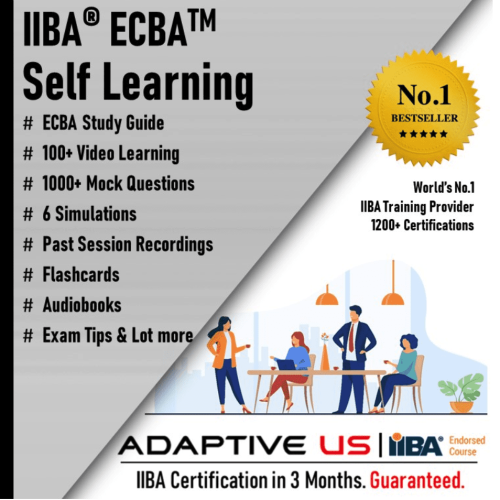
Business Analysis Approach Template
Having a set of business analysis planning and monitoring templates will help you provide the groundwork for the successful completion of your whole project.
Conclusion – Business Analysis Planning and Monitoring
In all business analysis projects whether waterfall or agile the business analyst will need to understand and review their business analysis planning and monitoring approach to suite the context of their project (and also when they arrived in the project).
This article has provided an introduction to the business analysis planning and monitoring activities necessary for the successful completion of the whole project.
Learn more about the other IIBA business analysis knowledge areas:
Jerry Nicholas
Jerry continues to maintain the site to help aspiring and junior business analysts and taps into the network of experienced professionals to accelerate the professional development of all business analysts. He is a Principal Business Analyst who has over twenty years experience gained in a range of client sizes and sectors including investment banking, retail banking, retail, telecoms and public sector. Jerry has mentored and coached business analyst throughout his career. He is a member of British Computer Society (MBCS), International Institute of Business Analysis (IIBA), Business Agility Institute, Project Management Institute (PMI), Disciplined Agile Consortium and Business Architecture Guild. He has contributed and is acknowledged in the book: Choose Your WoW - A Disciplined Agile Delivery Handbook for Optimising Your Way of Working (WoW).
Recent Posts
Introduction to Train the Trainer for a Business Analyst
No matter the industry, modern professionals need to continuously improve themselves and work on up skilling and re-skilling to maintain satisfactory success within their field. This is particularly...
CliftonStrengths for a Business Analyst | Be You
Today, the job of a business analyst is probably more challenging than ever. The already intricate landscape of modern business analysis has recently gone through various shifts, mainly due to the...
- Top Courses
- Online Degrees
- Find your New Career
- Join for Free

Business Analysis Mastery: Planning, Skills, and Perspective
This course is part of Certified Business Analysis Professional™ (CBAP®) Specialization
Taught in English

Instructor: Igor Arkhipov
Financial aid available

Recommended experience
Intermediate level
Participants should have a foundational understanding of business analysis principles and techniques.
What you'll learn
How to develop a comprehensive business analysis plan, including stakeholder engagement and governance strategies.
The importance of soft skills such as adaptability and behavioral characteristics in business analysis, with real-world applications.
Techniques for identifying performance improvements and effectively managing information to enhance business analysis outcomes.
Skills you'll gain
- Observation
- Adaptability
Details to know

Add to your LinkedIn profile
December 2023
1 quiz, 4 assignments
See how employees at top companies are mastering in-demand skills

Build your subject-matter expertise
- Learn new concepts from industry experts
- Gain a foundational understanding of a subject or tool
- Develop job-relevant skills with hands-on projects
- Earn a shareable career certificate

Earn a career certificate
Add this credential to your LinkedIn profile, resume, or CV
Share it on social media and in your performance review

There are 4 modules in this course
This advanced course, "Advanced Business Analysis Mastery," offers a deep dive into the intricacies of business analysis. Participants will gain expertise in planning, stakeholder engagement, governance, and information management. The course also emphasizes the importance of soft skills for business analysts, such as adaptability and effective communication. Learners will explore a range of perspectives relevant to business analysis, including Agile, Business Intelligence, IT, Business Architecture, and Business Process Management. By the course's conclusion, participants will have a comprehensive understanding of advanced business analysis concepts, the skills required to excel in this field, and the ability to approach complex business challenges with confidence and competence.
This course is ideal for experienced business analysts, project managers, and professionals involved in business analysis roles. It is tailored for individuals seeking to enhance their skills in planning, stakeholder engagement, and the application of various business analysis perspectives to drive organizational success. Participants should have a foundational understanding of business analysis principles and techniques. Prior experience in business analysis or related roles is beneficial. Familiarity with project management practices and basic business operations will enhance the learning experience. This course is suitable for those looking to advance their expertise in business analysis planning, skills, and perspectives, regardless of their prior knowledge level.
Business Analysis Planning and Monitoring
This module covers the critical aspects of planning and monitoring in business analysis. It includes techniques for developing a business analysis approach, engaging stakeholders, governance, information management, and identifying performance improvements.
What's included
17 videos 3 readings 1 quiz 1 assignment
17 videos • Total 95 minutes
- Overview • 4 minutes • Preview module
- Technique glossary • 6 minutes
- Plan business analysis approach part 1 • 6 minutes
- Plan business analysis approach part 2 • 5 minutes
- Plan stakeholder engagement • 6 minutes
- Technique stakeholder list map or personas part 1 • 5 minutes
- Technique stakeholder list map or personas part 2 • 6 minutes
- Technique stakeholder list map or personas part 3 • 5 minutes
- Technique stakeholder list map or personas part 4 • 6 minutes
- Technique stakeholder list map or personas part 5 • 2 minutes
- Technique organisational modelling • 6 minutes
- Plan business analysis governance • 6 minutes
- Plan business analysis information management • 5 minutes
- Identify BA performance improvements part 1 • 4 minutes
- Identify BA performance improvements part 2 • 5 minutes
- Technique observation part 1 • 3 minutes
- Technique observation part 2 • 5 minutes
3 readings • Total 15 minutes
- Welcome to the course • 5 minutes
- Business analyst health check questions • 5 minutes
- Reflection: Business analyst planning • 5 minutes
1 quiz • Total 4 minutes
- Business analysis planning • 4 minutes
1 assignment • Total 16 minutes
- Business analysis planning and monitoring • 16 minutes
Soft and Hard Skills for a Business Analyst
In this module, you will explore the essential soft and hard skills required for a successful Business Analyst. It covers behavioral characteristics, human skills, and the evolving role of a Business Analyst in today's landscape.
7 videos 2 readings 1 assignment
7 videos • Total 32 minutes
- Introduction to soft skills • 1 minute • Preview module
- Soft skills part 1 • 2 minutes
- Soft skills part 2 • 5 minutes
- Case study design sprint part 1 • 4 minutes
- Case study design sprint part 2 • 5 minutes
- Case study design sprint part 3 • 5 minutes
- Human skills for a business analyst • 6 minutes
2 readings • Total 10 minutes
- Business analysis tools - Essentials • 5 minutes
- How is the business analyst role evolving? - An interview with Igor • 5 minutes
1 assignment • Total 14 minutes
- Soft and hard skills for a business analyst • 14 minutes
Business Analyst Perspectives
This module introduces various perspectives that a Business Analyst may encounter in their role, including the Agile perspective, Business Intelligence perspective, IT perspective, Business Architecture perspective, and Business Process Management perspective.
18 videos 1 reading 1 assignment
18 videos • Total 100 minutes
- Perspectives • 2 minutes • Preview module
- Agile part 1 • 6 minutes
- Agile part 2 • 5 minutes
- BI perspective part 1 • 4 minutes
- BI perspective part 2 • 6 minutes
- IT part 1 • 7 minutes
- IT part 2 • 4 minutes
- Business architecture part 1 • 6 minutes
- Business architecture part 2 • 4 minutes
- BPM part 1 • 7 minutes
- BPM part 2 • 5 minutes
- BPM part 3 • 2 minutes
- Bonus video: Intro to agile part 1 • 5 minutes
- Bonus video: Intro to agile part 2 • 4 minutes
- Bonus video: Intro to agile part 3 • 7 minutes
- Bonus video: Intro to agile part 4 • 6 minutes
- Bonus video: Intro to agile part 5 • 7 minutes
- Bonus video: Intro to agile part 6 • 6 minutes
1 reading • Total 5 minutes
- Reflection: Business analyst perspectives • 5 minutes
- Business analyst perspectives • 14 minutes
Final Assessment
1 reading 1 assignment
- Final words • 5 minutes
1 assignment • Total 30 minutes
- Final assessment • 30 minutes

Our purpose at Starweaver is to empower individuals and organizations with practical knowledge and skills for a rapidly transforming world. By collaborating with an extensive, global network of proven expert educators, we deliver engaging, information-rich learning experiences that work to revolutionize lives and careers. Committed to our belief that people are the most valuable asset, we focus on building capabilities to navigate ever evolving challenges in technology, business, and design.
Recommended if you're interested in Business Essentials

Advanced Requirements Management & Solution Evaluation
Advanced business analysis: elicitation & analysis.

University of Maryland, College Park
Cómo manejar datos faltantes

Certified Business Analysis Professional™ (CBAP®)
Specialization
Why people choose Coursera for their career


New to Business Essentials? Start here.

Open new doors with Coursera Plus
Unlimited access to 7,000+ world-class courses, hands-on projects, and job-ready certificate programs - all included in your subscription
Advance your career with an online degree
Earn a degree from world-class universities - 100% online
Join over 3,400 global companies that choose Coursera for Business
Upskill your employees to excel in the digital economy
Frequently asked questions
When will i have access to the lectures and assignments.
Access to lectures and assignments depends on your type of enrollment. If you take a course in audit mode, you will be able to see most course materials for free. To access graded assignments and to earn a Certificate, you will need to purchase the Certificate experience, during or after your audit. If you don't see the audit option:
The course may not offer an audit option. You can try a Free Trial instead, or apply for Financial Aid.
The course may offer 'Full Course, No Certificate' instead. This option lets you see all course materials, submit required assessments, and get a final grade. This also means that you will not be able to purchase a Certificate experience.
What will I get if I subscribe to this Specialization?
When you enroll in the course, you get access to all of the courses in the Specialization, and you earn a certificate when you complete the work. Your electronic Certificate will be added to your Accomplishments page - from there, you can print your Certificate or add it to your LinkedIn profile. If you only want to read and view the course content, you can audit the course for free.
What is the refund policy?
If you subscribed, you get a 7-day free trial during which you can cancel at no penalty. After that, we don’t give refunds, but you can cancel your subscription at any time. See our full refund policy Opens in a new tab .
Is financial aid available?
Yes. In select learning programs, you can apply for financial aid or a scholarship if you can’t afford the enrollment fee. If fin aid or scholarship is available for your learning program selection, you’ll find a link to apply on the description page.
More questions
The Ultimate Guide to Business Analysis Planning
Why proper planning prevents poor performance.
It’s vitally important to define the objectives of your business analysis project, and show how those objectives are going to be met. Upfront.
Before I became a business analyst, I was a spatial systems analyst. My major at university was geographic information systems and during that time I was very fortunate to win short-term contract with a research centre.
My role was to define the requirements and implement an online spatial database for a very large pastoral property in the Northern Territory. It was a pilot and, bearing in mind that this was many years ago, the technology was very new for that part of the world.
What was also very new to me was the concept of a structured approach to planning and execution. When I was asked to present my plan to the project board, I went way off the reservation. The feedback was embarrassing. I had spent a lot of time and effort in getting it all wrong.
I was no longer at university. This was real work in the real world, but I had no idea what I was doing and no idea of what questions to ask. Fortunately people who did know surrounded me, and I was put on the correct path.
Here’s the thing. It’s vitally important to define the objectives of your business analysis project, and show how those objectives are going to be met. Upfront. This is so you are correctly aligned with the expectations and aims of the desired outcome.
Also, every organisation usually has a set of defined procedures and methodologies that informs the way you plan and carry out your business analysis effort. Using the organisation’s framework in conjunction with an understanding of the steps in the business analysis process will help you define the scope, your approach and the primary objectives of your work.
Proper planning and preparation prevents poor performance.
Planning is crucial, and so is checking with your stakeholders that the proposal is on the right path and meets their expectations. It is important not to skip it, or imagine that you know what you’re doing. Like I did all those years ago.
If I hadn’t been realigned with my work, I may have wasted considerable time and resources to achieve an outcome that didn’t suit the needs of my employer and their clients.
3 reasons why you should plan your business analysis activities
If you want to be more effective on your next BA project, it’s worth investing some time in planning your activities and approach.
As Business Analysts we must understand the importance of planning.
Without a way to describe our approach, it’s easy to get waylaid on a tangent or stuck in analysis paralysis. Often the overarching project initiation plan – typically written by the project manager – does not adequately cover the business analysis components of a project. If the BA work is not clearly defined, it can present a risk to project outcomes and stakeholder perceptions.
One way to overcome this is to develop a Business Analysis Approach document which describes the activities, deadlines and approach to delivering your work. This document can work in conjunction with a project plan or as a standalone item.
Here are 3 reasons why you should plan your next Business Analysis effort.
1. You improve your communication.
A very important part of successfully completing your work is communication with your stakeholders. The BA Approach Document clearly describes what you will deliver and why. It sets the expectations on how you perform your work, the resources you need and the types of activities you will engage in, e.g. workshops and interviews. So everybody is on the same page! Planning also increases the transparency of your work as the small processes of your work are better understood. This helps when expectations have to change.
2. You’re better organised
In developing the Business Analysis Approach you’ve laid out all aspects of your work in front of you. Not only does this benefit your stakeholders, but you have a clear and agreed path to follow. This prevents tangents and over analysis. Having a plan also helps when you are working on multiple projects or activities. This is because you need to consider timeframes for your activities, and any other outside work that will impact on them.
3. You’re more focussed on the goal
A project plan is not only important for communication with your stakeholders, it’s also valuable to keep you on track. It’s a way of keeping your work aligned to the finished product. With every activity you perform, you should ask yourself if it is relevant to the end product. Ask yourself, “What value am I adding here? Is this relevant to what I’m delivering? Is this in the plan?”
The number one thing Business Analysts should avoid
By adequately considering the goals and objectives of a project, the problem you’re solving, and the desired organisational outcomes, you will be better placed to focus your activities in the right direction.
There’s a lot written on the topic of common mistakes made by business analysts. That’s because considerable thought is given to how good business analysis practice can add value to an organisation, which is important for sustainability and growth.
Some of the bigger issues for business analysts are:
- Failure to see the bigger picture and the problem that needs to be solved, which results in poorly aligned deliverables,
- Being too solutions focussed, which leads to requirements written for a solution that does not satisfactorily meet the needs of the organisation,
- Missing requirements in the specification or requirements are poorly expressed, which causes misinterpretation and wasted time in rework,
- Poorly managed requirements due to inadequate tool support (i.e. no traceability), and
- Inadequate stakeholder involvement, which results in signing off requirements without sufficient collaboration and verification from all user classes.
In my experience, the risk of these issues occurring can be significantly reduced with good planning . In my opinion, not planning your work is the one mistake that business analysts must avoid from the outset.
By adequately considering the goals and objectives of a project, the problem you’re solving, and the desired organisational outcomes, you will be better placed to focus your activities in the right direction. And you’ll mitigate the larger risk of some of those common business analysis mistakes occurring.
Of course there’s no guarantee, but you are putting your best foot forward by taking the time to think through your approach. And that gives you the comfort of knowing that you’ve done your best to communicate and mitigate any identifiable risks to the project at the level of your work.
Recommended resources

Business Analysis Approach Planning Template
Make a great start on your next project with the Business Analysis Approach Template. This template helps you set the expectations on how you perform your work, the resources you need and the types of activities you will engage in, e.g. workshops and interviews. So everybody is on the same page! Planning also increases the transparency of your work as the small processes of your analysis are better understood. This helps when expectations have to change. A well written plan will help you communicate exactly what’s required of you and your stakeholders to produce the necessary deliverables for your business analysis effort, and why.
- Skip to main content
- Skip to primary sidebar
- Skip to footer
Additional menu

6 business analysis techniques to use in your strategic plans
August 10, 2021 by MindManager Blog
By: Emily Finlay
For businesses, efficiency and effectiveness are key. Whether you’re executing a major project or determining the best ways to train new employees, it’s important to use best practices to achieve exceptional results.
Business analysis uncovers the strategies and processes that can help your business improve. You can find the flaws in your operations while determining what you need to change to fix them. Auditing and refining your business also offers the insights you and your leadership need to make informed decisions that will benefit your work moving forward.
Like any method, however, the power of business analysis depends on the methods used to execute it. In this guide, we’ll walk you through the top business analysis techniques. You’ll learn what each option offers and how you can use them to analyze your own processes.
What are business analysis techniques?
Business analysis techniques are the specific processes used to audit and improve business operations. These step-by-step procedures help analysts stay organized and make strategic decisions during the analysis.
What are the different types of business analysis techniques?
The most common types of business analysis include BPM, SWOT, MOST, CATWOE, PESTLE, and Six Hats Thinking. These planning methods can be used in a variety of industries and projects. From streamlining your operations to aligning your company’s purpose, these tactics can maintain your organization’s long-term success.
Business Process Modeling (BPM)
This technique, also known as business process mapping , creates a visual representation of the procedures a company uses. By visualizing the processes, teams and analysts can identify any problems. They can also see where efficiency is lost.
As you develop strategies to address these shortcomings, you can apply them to the model to see how they will affect the targeted process. This will also highlight any potential problems that these changes might create in other areas.
Business analysis steps: BPM
According to the International Institute of Business Analysis , here are the steps you should follow:
- Strategic planning – Start by researching and understanding the processes and problems you’re going to solve. Discover everything involved before creating your model.
- Business Model Analysis – Develop a model (such as mind mapping , flow charting, or diagramming) of the business processes with the information gained in step one. Analyze this visual and use it to guide your strategies.
- Define and design the process – Create the solutions you need and apply them to the model.
- Technical Analysis for complex business solutions – Use your visualization to analyze and improve the solutions.
Business analysis example: BPM
If a company is changing the way they produce a specific product, this technique can help them understand how adjusting that element will impact others. Rather than theorizing, they can use a visual flow to pinpoint obstacles and areas of improvement.
Strength, Weakness, Opportunities, Threats (SWOT)
These four elements define this technique, identifying internal (Strengths and Weaknesses) and external (Threats and Opportunities) factors. The most popular type of business analysis, SWOT drives informed decision making in nearly every area of business.
Business analysis steps: SWOT
Create a map with four quadrants, as outlined below, and use it guide your solutions and decisions:
- Strengths – What processes, resources, and other factors give us an advantage over competitors?
- Weaknesses – What holds us back from doing better and growing?
- Opportunities – What is happening outside the business that we can use to our advantage?
- Threats – What external factors can limit or hurt our success?
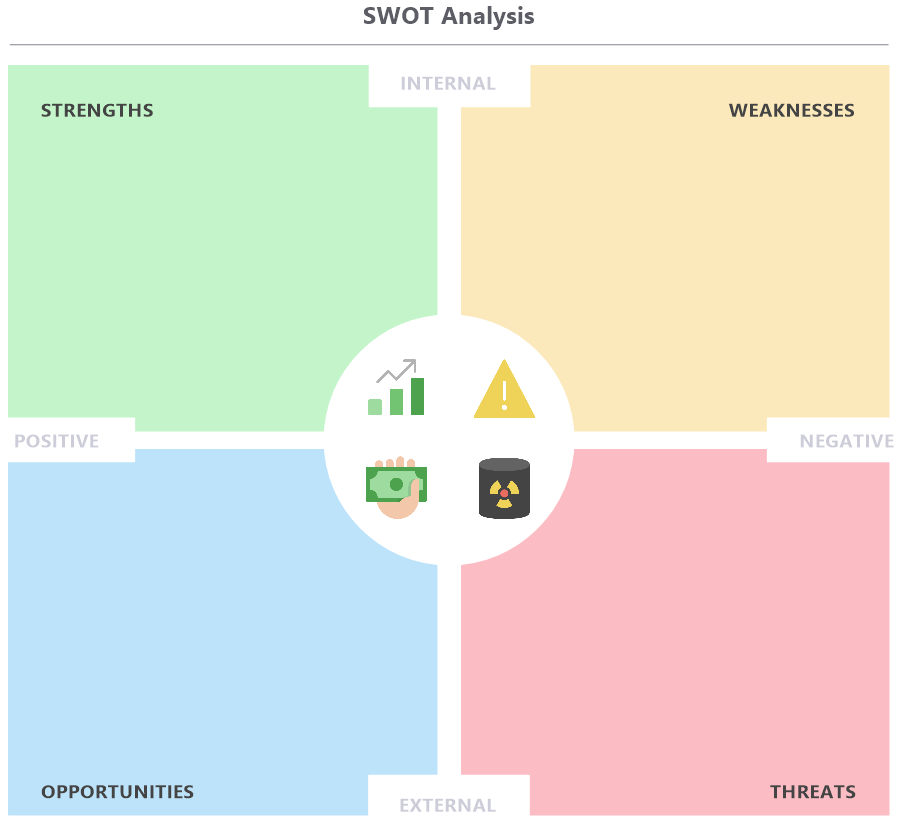
Business analysis example: SWOT
You can apply this technique to performance reviews, using the information you gain to help employees make improvements and celebrate strengths.
Mission, Objectives, Strategies, and Tactics (MOST)
If you want to make sure your company is maintaining its main goals through every decision and transition, MOST is the best tactic to use. By analyzing your business based on the following elements, you can turn big-picture objectives into achievable actions.
- Mission – Your overarching purpose that defines everything you do.
- Objectives – The goals necessary to accomplish your mission.
- Strategies – What you need to do to reach your objectives.
- Tactics – How everyone in the organization can execute your strategies.
Business analysis steps: MOST
Starting from the top down, define these four elements for your business. Then, use them to create processes that prioritize your main goals throughout the organization.
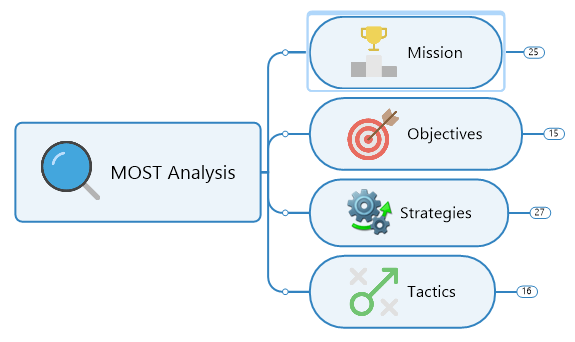
Business analysis examples: MOST
When rebranding a company, the MOST technique helps you discover and refine the heart of your organization. You can realign your processes, products, and marketing efforts to reflect your goals more accurately. If your company has strayed from these primary values or shifted to new ones, MOST will help you clearly define your views and objectives.
Customers, Actors, Transformation, Worldview, Owner, Environmental constraints (CATWOE)
Your individual stakeholders’ viewpoints affect your goals and processes. Every change also affects all of your stakeholders. With CATWOE, you can understand how any action impacts your organization, customers, leadership, and more.
Business analysis steps: CATWOE
This technique should be used at the start of the project or strategizing process. Begin by defining these parties and asking these questions:
- Customers – Who benefits from your work and products? How does this issue or the proposed solution affect them?
- Actors – Who is directly involved in this process? How will they affect it?
- Transformation – What are the ultimate changes that will occur by implementing this solution or new procedures?
- Worldview – How will this change affect the organization’s mission and big picture?
- Owner – Who is responsible for the affected system and how are they related to it?
- Environmental constraints – On every level, what are the limitations that affect the solution?
Once you have these answers, use them to guide your strategies and final solutions.
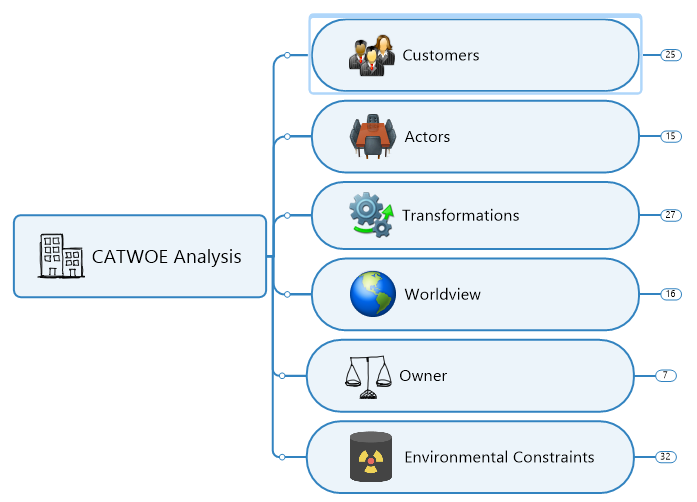
Business analysis examples: CATWOE
If a development company wanted to build a new shopping center, they could use this technique to understand the impact it would have on the company, their future customers, and the people living in the surrounding community.
Political, Economic, Social, Technological, Legal, Environmental (PESTLE)
Decisions and changes aren’t made in a vacuum. PESTLE identifies outside factors that will affect the decisions made within an organization, as well as how the company’s changes will impact other factors. This technique allows businesses to plan for any potential threats that might develop and strategize for seizing new opportunities.
Business analysis steps: PESTLE
Walk through the following list to determine the forces that can impact your organization.
- Political – How do government policies, initiatives, and financial support affect your business and your proposed solution?
- Economical – What is the economic climate and how does it affect you?
- Social – How do trends and attitudes concerning population, media, culture, lifestyle, and education affect the business?
- Technology – What is the rate of technological development, particularly for information and communication, and how does it impact your changes?
- Legal – Do local and national regulations and employment standards affect your work? How?
- Environmental – Are weather, pollution, waste, and recycling factors a concern for your organization? What is their impact?
Use this information to prepare for threats and opportunities that might affect your business’ ongoing performance.
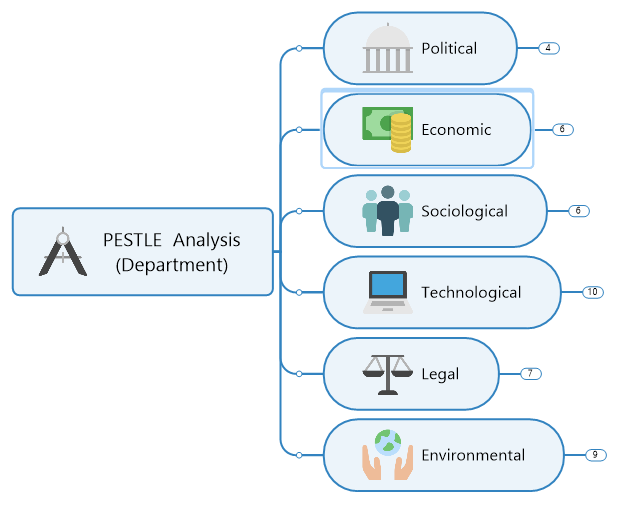
Business analysis examples: PESTLE
When using the SWOT technique to evaluate your company’s direction and future, you can use PESTLE to develop and analyze each element of the process. This will help you create a more detailed understanding of your business, particularly concerning threats and opportunities.
Six Thinking Hats
Often, teams lack enough diverse viewpoints to find and understand the issues that are keeping them from full success. With the Six Thinking Hats technique , you can use different ways of thinking to uncover new perspectives. Using these new insights during brainstorming sessions can hone your team’s ideas for better results.
Business analysis steps: Six Thinking Hats
In your meetings, consider the problem and possible solutions with the type of thinking dictated by each “hat” and step.
- Start with the White Hat, which focuses on hard data and logic. What information do you know or need?
- Move to the Yellow Hat, which stands for brightness and positivity. Look for the possible values and benefits through optimistic thinking
- Now play devil’s advocate with the Black Hat of judgment. Find potential problems, obstacles, and threats.
- The Red Hat focuses on intuition. Share your feelings, fears, hunches, and emotions associated with the solution or process.
- Use the Green Hat of creativity to consider possibilities, thoughts, and ideas. Try to think outside the box.
- With the Blue Hat, you will bring your brainstorming back to earth. Consider the big picture of the project or changes. Ensure your ideas fit your operations and procedures.
- Use this process to hone your solutions and approach to problems.

Business analysis example: Six Thinking Hats
The next time you think your project needs fresh eyes, gather your team for a Six Thinking Hats brainstorming session. You will be able to view your work in a new light and uncover ways to improve.
There isn’t a “right” technique for business analysis. Instead, use these tactics as they best fit your objectives. And don’t be afraid to combine these techniques for a single problem. As you analyze your business through different lenses, you can find the solutions that will offer the greatest benefits.
Ready to take the next step?
MindManager helps boost collaboration and productivity among remote and hybrid teams to achieve better results, faster.
Why choose MindManager?
MindManager® helps individuals, teams, and enterprises bring greater clarity and structure to plans, projects, and processes. It provides visual productivity tools and mind mapping software to help take you and your organization to where you want to be.
Explore MindManager

IMAGES
VIDEO
COMMENTS
Use the Universal Business Analysis Planning Checklist as You Plan Your Business Analysis Approach. Every project is a unique, temporary endeavor. The business process management, regulatory compliance and digital transformation projects that business analysts may play a role in all come with different goals, scopes, teams, timelines, budgets dependencies and risks. Though many projects follow
business analysis activities. There may be a prescribed methodology that has already determined what business analysis activities need to be performed. Agile and waterfall development styles require different types of business analysis deliverables. Location of Stakeholders Where are all of the solution stakeholders going to be located?
To plan business analysis governance is to define business analysis components that will serve as a support of governing function in an organisation. It’s defining how decisions are made on all aspects of the business, including designs, requirements, reviews, changes, and prioritisation.
There are 4 modules in this course. This advanced course, "Advanced Business Analysis Mastery," offers a deep dive into the intricacies of business analysis. Participants will gain expertise in planning, stakeholder engagement, governance, and information management. The course also emphasizes the importance of soft skills for business analysts ...
5. Choose your approach. Be the first to add your personal experience. 6. Review and update your plan. Be the first to add your personal experience. 7. Here’s what else to consider. A business ...
One way to overcome this is to develop a Business Analysis Approach document which describes the activities, deadlines and approach to delivering your work. This document can work in conjunction with a project plan or as a standalone item. Here are 3 reasons why you should plan your next Business Analysis effort. 1. You improve your communication.
Plan Business Analysis Approach To define an appropriate method to conduct business analysis activities. Ensure the efficient performance of all business analysis activities with a stakeholder-supported approach. A defined business analysis approach that includes planned activities, tasks, and deliverables.
The most common types of business analysis include BPM, SWOT, MOST, CATWOE, PESTLE, and Six Hats Thinking. These planning methods can be used in a variety of industries and projects. From streamlining your operations to aligning your company’s purpose, these tactics can maintain your organization’s long-term success.
Introduction 10.1 Acceptance and Evaluation Criteria 10.2 Backlog Management 10.3 Balanced Scorecard 10.4 Benchmarking and Market Analysis 10.5 Brainstorming 10.6 Business Capability Analysis 10.7 Business Cases 10.8 Business Model Canvas 10.9 Business Rules Analysis 10.10 Collaborative Games 10.11 Concept Modelling 10.12 Data Dictionary 10.13 ...
Plan several rounds of edits or have someone else review it. Keep everything in the context of your business. Make sure all the statistics and data you use in your market analysis relate back to your business. Your focus should be on how you are uniquely positioned to meet the needs of the target market.